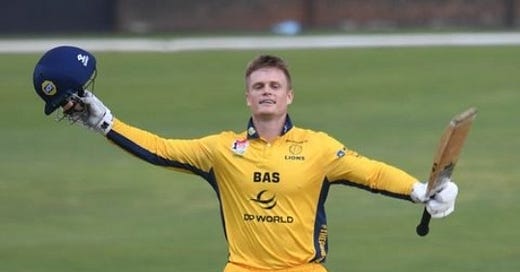Ryan Rickelton’s ankle has been the subject of many discussions over the past few weeks. It was cited as the reason why he was not considered for selection. But, Rickelton has been scoring runs and keeping wicket for the Lions exceptionally well, picking up player-of-the-match accolades and hanging around the top on the lists of most run-getters in franchise cricket. So, what’s up with his ankle?
Hello, welcome to Stumped! If you are not yet a subscriber, join more than a thousand other professional athletes & ex-pros, coaches, commentators & analysts and casual sports fans that receive the newsletter in their inbox each week — it’s free:
Ryan Rickelton was not in pain as he prepared for his next assignment for the DP World Lions. There was no discomfort. His ankle was fine.
In mid-November, he was in pain, emotional pain born out of disappointment. He was deemed ineligible for selection for the Proteas' tour to Australia. International cricket has always been his dream and Australia versus South Africa contests had played a massive role in those dreams. From the time when he was a youngster and routinely stayed up late to watch the Proteas take on Australia in Sydney, Melbourne, and Brisbane.
On some days, Rickelton woke up in the early hours of the morning to catch the Boxing Day or New Year’s Tests down under. His parents hardly noticed because he kept the noise down as much as possible and didn't give any problems the next morning. He was organised.
When he was around five or six, Rickelton’s father hung a tennis ball from a tree close to the garage for the youngster. It required imagination, but on many weekend mornings, as Rickelton hit his way to a targeted number of runs from the tennis ball, he saw himself piercing the field off the bowling of Brett Lee and other Australian bowlers.
But, Rickelton did not let the sting of non-selection eat away at him. It's part of the game that one will be overlooked for one reason or the other. It is what it is. There will be other opportunities in the future, he told himself. Instead of wallowing in self-pity, Rickelton peeled off two unbeaten centuries (100* and 108*) in two First Class matches for the Lions. He scored 240 runs, at an average of 120 and a strike rate of 47.68.
His tally left an exclamation mark, rather than a question mark, on his form and fitness.
This Substack column exists thanks to patrons and readers that leave tips. Stumped! is wholly supported by Readers Like You. To keep the weekly posts coming and to keep the lights on here, consider leaving a tip or supporting monthly on Patreon. You won’t regret it!
This newsletter also reaches more people because you share it with others:
Ryan Rickelton had never had any major issues with his ankle before, that is, besides the odd niggle here and there. There have been times when he felt a tightness in his ankle in the past, but that has always been easy to resolve. A short visit to the physio and all was sorted.
The first time he felt severe pain and discomfort was during the Proteas' tour of England. The team did a running session around the sports fields at the London School of Economics - the Proteas were given access to the School of Economics grounds for their preparation for the Test against England at the Oval. A significant section of where they ran had long, thick grass. It is possible that running through that section was a contributing factor to exacerbating an existing issue. Rickelton probably damaged his ankle years ago.
"When we were kids we used to jump on the trampoline a lot. I definitely sprained both of them around that time," says Rickelton.
Naturally, because Rickelton is an avid runner and enjoyed other sports growing up, it's possible that a twist here and a tear there might have gradually damaged his ATFL ligament. The ATFL ligament or anterior talofibular ligament is the part that gave Rickelton issues.
After the session around the School of Economics, Rickelton paid the Proteas' physiotherapist a visit. The physio helped him ease the pain and tightness around it. The next morning there was a bit of tightness around it, but Rickelton did not think much of it. It felt like a niggle. After the Test at the Oval, the distant pain returned, but, again, he did not think much of it.
Rickelton only realised that past methods of dealing with his ankle were not going to do the job after the team had returned to South Africa. His foot had swollen up after a few training sessions with the Lions.
The only way Ziyaad Mohamed, the Lions' physiotherapist, was going to know what was going on was if he took an x-ray of the foot. After a few minutes, the swelling had reduced enough to see what was happening, thanks to anti-inflammatories. The images showed that there was damage. It looked bad. Mohamed needed more information, so he suggested an MRI scan. Rickelton went to Rosebank Radiology for the scan.
When Duanne Olivier was 18, he hurt his back. When Olivier and his father paid a visit to the local back doctor for treatment, the doctor could not understand how Olivier had been able to walk into his practice, let alone bowl. The doctor was lost for words. The doctor who oversaw Rickelton's MRI scan had the same reaction. Nothing made sense. Rickelton's ATFL ligament was torn and there was a bone spur on his heel pushing on his Achilles.
"He said because I have been working it for so long, the other ligaments and muscles are all firing really well so that's what was keeping the ankle strong and secure. But we do need to operate on the ATFL," says Rickelton.
But, Rickelton had a packed summer of cricket ahead of him. An operation would put him out of commission for a minimum period of two months. In professional cricket, the caravan moves on quickly. There is always another cricketer ready to step in and stake a claim. No one is safe from being replaced. After one is replaced, it’s easy to be shuffled to the bottom of the pile.
Rickelton inquired about ways to delay the operation, manage the situation and be able to perform at his best without causing further damage. These are the decisions professional athletes make all the time. Jimmy Anderson went through a period when his game was held together by ibuprofen.
During a 2006 tour of India, Anderson went through six ODIs with back pain, which the England medical team thought was due to a stiff back but turned out to be a stress fracture. Ibuprofen saw him through those matches. Anderson has also played through severe shoulder pain. Over the course of his career, Anderson has put on so much strain on his shoulder that getting out of his seat after flights can be a struggle. It hurts when he puts a T-shirt on in the morning. Sometimes he feels pain when he brushes his teeth.
Anderson has written in his book that there haven't been many occasions when he has bowled pain-free.
If there was a way, Rickelton was prepared to take his chances with it. There was a way: platelet or PRP injections. Rickelton received three sets of injections. The injections improved the muscles, ligament and tendons around the ankle. That was half the battle.
Rickelton received the last of the PRP injections while he was taking part in the CSA T20 Challenge. He was still moving around gingerly. He was in a bit of pain and feeling a bit of discomfort. During the tournament, Rickelton scored 76 runs in 5 innings at an average of 15.2 and a strike rate of 131.03.
The other half was cortisone injections and continued daily rehab work. While the PRP injections accelerate the healing of injured tendons, ligaments and muscles, cortisone shots take care of inflammations and provide pain relief.
By the time the 4-day series came around, Rickelton was pain-free. His bag full of runs sent him to the top of the run-getters list. He has carried his 4-day cricket form to the one-day series. So far, he has made scores of 126 and 99, for an average of 112.5 and a strike rate of 101.35.
“I can still run, which is good for me. I also get to play white-ball cricket for a bit, which I haven’t done a lot due to tours and other commitments, and hopefully carry some momentum into SA20,” says Rickelton.
There is a big summer ahead, and Rickelton is only getting started. He has a 6-month to one-year window before surgery becomes necessary, and by the time he goes under the knife around March or April 2023, Rickelton hopes to have made the most of his abilities. Medically, he is fit. Game-wise, his form is better than most.







